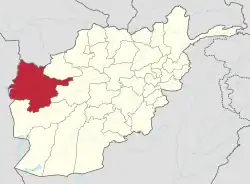Gawhar Shad Mosque (Herat)
| Gawhar Shad Mosque | |
|---|---|
 The mosque viewed from the east in 1863 (by Durand, Illustrated London News) | |
| Religion | |
| Affiliation | Islam (former) |
| Ecclesiastical or organisational status | Mosque (1438–1885) |
| Status | Closed (ruinous state) |
| Location | |
| Location | Musalla Complex, Herat |
| Country | Afghanistan |
 Location of the former mosque in Afghanistan | |
| Geographic coordinates | 34°21′21″N 62°11′05″E / 34.3557°N 62.1847°E |
| Architecture | |
| Architect(s) | Qavan ud-din |
| Type | Mosque |
| Style | Timurid |
| Founder | Queen Gawhar Shad |
| Completed | c. 1438 |
| Demolished | 1885 |
| Minaret(s) | Four: (one extant) |
.png)
The Gawhar Shad Mosque (Masjid-i Jami‘ of Gawhar Shad) is a former mosque, in a ruinous state, located in Herat, Afghanistan. The mosque was built under a commission by Gawhar Shad, the main queen of the Timurid ruler Shah Rukh and is located in the southwestern corner of the Musalla complex.[1]: 94 The structure has not operated as a masque since the latter part of the 19th century.
Structure
The mosque was commissioned by Gawhar Shad, and built by the architect Qavam al-Din b. Zayn al-Din Shirazi, after he had finished the Gawhar Shad mosque in Mashhad in 1418. Construction began in 1417–18, and partial completion was achieved in 1437–38.[1]: 102–104 The mosque measured c. 130 by 74 metres (427 by 243 ft), and was built around a four-iwan structure and crowned by four minarets.[1]: 102–104 The decoration consisted in blue glazed tiles, in a style similar to that of the nearby Gawhar Shad Mausoleum.[1]: 102–104
The mosque was demolished by Afghan-British troops in 1885, in the Panjdeh incident, in an effort to prevent the potential use of the ruins by invading Russian troops as a defensive structure or protective terrain, and to provide a clear line of sight from the Herat fortress.[1]: 102–104 [2] As of 1928, only two minarets remained in partially good shape: minaret No.8 at the southeast corner, and minaret No.6 at the northwest corner. Today, nothing remains, apart from the half-length ruins of the northwestern minaret No.6, almost without any decoration left.[3]: 5, Figure 8
A few decorative slabs from minaret No.8 have been reused in the Shrine of Khwaja Abd Allah of Herat.[3]: Figure 3
In 2004, UNESCO added the City of Herat, including the entire Musalla complex, to the Tentative List of UNESCO World Heritage Sites.[4]
Minaret No.8 (southeast corner)
Minaret No.8, the minaret at the southeast corner of the mosque, was still standing in 1928, but has since disappeared.[3]: 5, Figure 8 The decorative slabs at the basis have been reused in the Shrine of Khwaja Abd Allah of Herat.[3]: Figure 3 Some are also displayed in the Great Mosque of Herat.[5]
-
![The Gawhar Shad Mosque minaret No.8 (southeast), 1928.[3]: Figure 8](./_assets_/Gawhar_Shad_Mosque_southeast_minaret_(minaret_No.8)%252C_with_other_minarets_in_the_background_(Herat%252C_Afghanistan)._Fr%C3%A9d%C3%A9ric_Gadmer%252C_1928.jpg) The Gawhar Shad Mosque minaret No.8 (southeast), 1928.[3]: Figure 8
The Gawhar Shad Mosque minaret No.8 (southeast), 1928.[3]: Figure 8 -
._Fr%C3%A9d%C3%A9ric_Gadmer%252C_1928.jpg) Gawhar Shad Mosque minaret No.8 (southeast), 1928
Gawhar Shad Mosque minaret No.8 (southeast), 1928 -
._Fr%C3%A9d%C3%A9ric_Gadmer%252C_1928.jpg) Detail of the mosaics of the minaret No.8 (Southeast), 1928
Detail of the mosaics of the minaret No.8 (Southeast), 1928 -
![Decorative slab, from the base of minaret No.8.[3]: Figure 3 [5]](./_assets_/Gawhar_Shad_Mosque_southeastern_minaret_(No.8)%252C_detail_of_stone_epigraphic_panels_at_base.jpg)
Minaret No.6 (northwest corner)
Only a half-length stump remains today of minaret No.6 (at the northwest corner of the mosque), with very little decoration left, damaged by Russian mortar fire in 1985.[3]: Figure 3
-
._Musalla_Complex_(Herat%252C_Afghanistan)._Fr%C3%A9d%C3%A9ric_Gadmer%252C_1928.jpg) Minaret No.6 (northwest), 1928
Minaret No.6 (northwest), 1928 -
_._Musalla_Complex_(Herat%252C_Afghanistan)._Fr%C3%A9d%C3%A9ric_Gadmer%252C_1928.jpg) Minaret No.6 (northwest), 1928
Minaret No.6 (northwest), 1928 -
.jpg) Detail of underglazed ceramic tiles with “blue-and-white” decorations from minaret M6
Detail of underglazed ceramic tiles with “blue-and-white” decorations from minaret M6 -
._National_Museum_of_Herat.jpg) Sherds of mo'araq cut-tile mosaic from minaret M6, Gawhar Shad Mosque (Herat). National Museum of Herat.
Sherds of mo'araq cut-tile mosaic from minaret M6, Gawhar Shad Mosque (Herat). National Museum of Herat.
References
- ^ a b c d e Khairzade, Khair Mohammad; Franke, Ute (2020). "The 'Musalla'-Complex in Herat Revisited: Recent Archaeological Investigations at the Gawhar Shad Madrasa". In Ahrens, Alexander; Rokitta-Krumnow, Dörte; Bloch, Franziska; Bührig, Claudia (eds.). Drawing the Threads Together Studies on Archaeology in Honour of Karin Bartl.
- ^ Allchin, Raymond (2019). The Archaeology of Afghanistan: From Earliest Times to the Timurid Period (Revised and updated ed.). Edinburgh: Edinburgh University Press. p. 559. ISBN 978-0748699179.
- ^ a b c d e f g Aube, Sandra; Lorain, Thomas; Bendezu-Sarmiento, Julio (2019). "The Complex of Gawhar Shad in Herat: New Findings about its Architecture and Ceramic Tile Decorations (View supplementary material)". Iran Journal of the British Institute of Persian Studies. Iran. doi:10.1080/05786967.2019.1571769.
- ^ "Tentative List: City of Herat". unesco.org. UNESCO. August 17, 2004. Retrieved November 15, 2019.
- ^ a b "Masjid-i Jami'". www.archnet.org. n.d.
External links
![]() Media related to Gawhar Shad Mosque (Herat) at Wikimedia Commons
Media related to Gawhar Shad Mosque (Herat) at Wikimedia Commons
